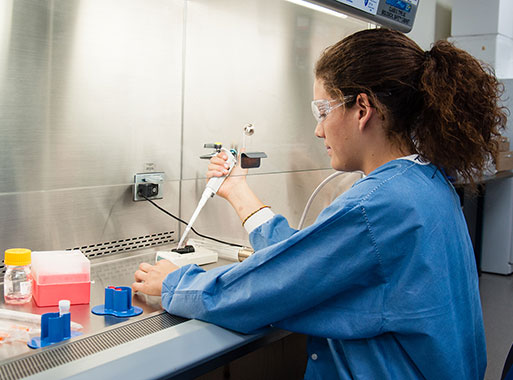National Science Foundation taps college to educate stem cell professionals

Madison College student Tyler Nevels prepares dilutions for cell counting.
September 29, 2015
The National Science Foundation (NSF) has awarded Madison College a grant of $661,000 to expand its current two- semester stem cell certificate program. This grant will aid in the ongoing effort to keep Madison College at the forefront of stem cell education and training.
The current program started in 2007 as a small, federally funded pilot program. It has flourished into a one of a kind career path in the multi-billion dollar industry of stem cell research and regenerative medicine. According to Thomas Tubon, director of the grant initiative at Madison College, the pilot program led to a full-scale grant of more than $850,000 from the NSF, which ran for the past four years. The goal of that grant was to develop the current stem cell training program, as well as to build and remodel the facilities to house the courses.
At 2,744 square feet, the advanced cell culture education suite is modeled after industry standards. According to Tubon, “it is equipped with all the bells and whistles of a state of the art laboratory.” The current suite is what you would expect to see at a research university such as the University of Wisconsin – Madison.
With support from the NSF, City College of San Francisco, support from within our institution and the UW-Madison, as well as support from within the industry, Madison College will continue to train and educate future stem cell researchers. Madison College is one of approximately six programs in the US that train stem cell researchers.
“We’re the flagship for the creation of this program,” said Tubon. Madison College is the only program that has on site facilities that support human stem cell education.
The grant that was awarded to Madison College earlier this month has four goals:
- To develop teaching material to bring stem cell education into high schools and middle schools.
- To allow the program to continue to evolve so that it remains in lockstep with current and emerging technologies. “The field is changing so fast that if we don’t do this then we will fall behind the times very, very quickly,” Tubon stated.
- To aid in the dissemination of the program’s structure and success. This is how Tubon and his colleagues recruit other colleges across the US, “so that they may adopt what we’ve created.”
- To create a sustainable learning community, so that when institutions do create programs like this one, or adopt aspects from it, “…we can provide a resource for them so that they can also continue to evolve the things that they do, or turn to us … for additional support of the curriculum or technologies they wish to bring into the classrooms,” Tubon asserted.
In order to secure funds from the NSF, “…which can be a bit of a heavy, competitive process,” Tubon explained, “and there has to be a lot of support from within the institution.” You also need the infrastructure, and partners in the industry and academia, which includes The UW–Madison Stem Cell and Regenerative Medicine Center. Also required is a large-scale plan for impact.
“When we create these things … we ask ourselves, ‘How can we use what we’ve created to impact the way that education is delivered across the United States?’” said Tubon.
The new grant will allow the incorporation of new technologies and techniques into the coursework, which is extremely dynamic.
“When something comes out in the industry that’s relatively new, we do what we can to bring that into the classroom,” Tubon said.
Last spring, UW-Madison published a paper which showed how researchers were able to take stem cells and, as Tubon describes, “push them into neurons,” or neural precursors – in just seven days. Within a month of that publication, Madison College students in the stem cell program were performing the same experiments, creating their own neural precursors in the lab.
The program teaches techniques that are aligned with industry. Staying in lockstep with current techniques will provide students with training that makes them competitive in the job market.
Pushing the envelope in pursuit of new research, Tubon affirms, is not the goal of the program. The mission of this program is to train students in the process of the development of new products, or treatments.
“Our principal charge with this program is to stimulate the economy, to create those jobs and create new opportunities for our students,” said Tubon.
Since the start of the program, about 50 students have graduated, with 13 currently enrolled. Of those students Tubon has kept in contact with, 96 percent of students completing the program have found work in the field.






























